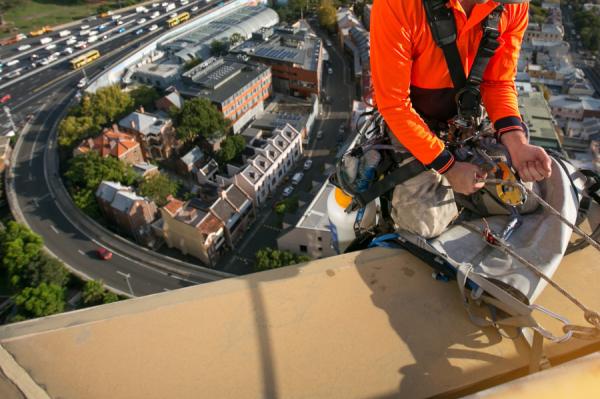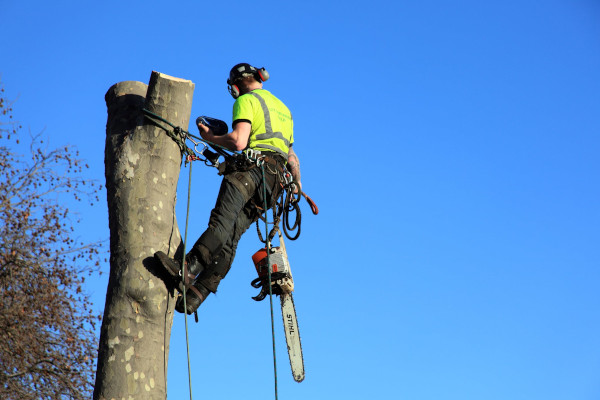Blog Post
The Do’s and Don’ts of Working at Heights Training

Working at heights, as the term suggests, refers to anyone who does any type of work at an elevated level where, if the proper safety precautions are not adhered to, a person could fall and severely injure themselves should an accident occur. This height can generally be considered to be at two metres or more, though there isn’t any exact specification.
As such, the obvious risk associated with working in these circumstances requires proper working at heights training to reduce the chances of accidents taking place that could result in injury or death. While the working at heights training that EMCARE offers covers all the technical aspects, there are some palpable dos and don’ts when it comes to working at heights. In this article, we take a look at what some of these are.
Jobs that require working at heights
Working at heights is considered to occur in any place where the risk of a person falling and injuring themselves is prominent. Although not specifically defined, it can be generally accepted to be where someone runs the risk of falling a distance of two metres or more. So, with this in mind, let’s take a look at some of the most common occupations that require working at heights training.
Tree Trimmers:
Tree trimmers cut and prune trees for several reasons such as tree health, aesthetics, and safety purposes. Subsequently, tree trimmers are widely sought after over a range of sectors that require tree maintenance, making it a lucrative career for anyone who loves heights, the outdoors, and working with their hands. Considering that the working environment is ever changing (because no two trees are the same) it’s imperative for tree trimmers to have the correct safety training.

Wind Turbine Technicians:
Wind turbine technicians are required to install wind turbines and perform maintenance on the devices regularly. The turbines’ heights can range drastically from rather low to incredibly high. Working at these heights in locations where the wind is such a prominent factor brings even greater risk and an even bigger need for adequate working at heights training.
Electrician:
While electricians generally work at ground level, they are often required to conduct work at heights too. The height can range from working in ceilings to multiple stories on commercial buildings. Electrical work already has its prevalence and dangers even without the risk of heights associated. When the two are combined, the need for safety increases and it’s easy to see why.
Glaziers:
A glazier is someone who installs or removes glass from windows, doors, skylights, displays, and storefronts. This is often accompanied by installing the framework as well which requires physical strength and stamina. Over and above this, a large part of glaziers’ work takes place at heights as virtually all tall buildings require window installation. Having the correct working at heights training will ensure that glaziers can go about their work safely and confidently.
Window Cleaners:
Just like glaziers, a large part of a window cleaners job takes place at heights as large buildings require their windows to be kept clean. Window cleaning work is mostly carried out from a hanging platform that is suspended by ropes and window cleaners are required to wear harnesses to ensure their safety.

Roofers:
At a minimum, roofers work at a height of at least one storey high, making it high enough for significant injury to occur should an accident happen. And while most roofs can be considered safe to easily move and work on, the danger increases when the pitch of a roof makes it difficult, or even impossible to do so. It is in such instances where working at heights training can be beneficial in not only ensuring safety, but in many cases simplifying how the work is conducted.
In an ideal world, every task would have been achievable and doable from a safe place on the ground. Unfortunately, this is just not the case in our actual world and some things have to, and always will be, conducted at heights. If you’d like to learn more or pursue possible careers that involve working at heights, take a look at one of our previous articles, Careers for Those Who Love Heights, where we covered the details of these jobs a little more in-depth.
The do’s and don’ts of working at heights
Like with just about any job in any sector, there are certain ways you can go about conducting the required tasks and certain ways you really shouldn’t. However, while small mistakes in other sectors won’t typically have any life-threatening consequences, the tiniest errors when working at heights, can lead to serious injury or even prove to be fatal.
Accidents that happen at heights can usually be attributed to unsafe conditions, lack of safety knowledge, negligence, or improper conduct. It’s for these reasons that it’s imperative that the working at heights training is completed by anyone whose jobs require them to work at an elevation.
The DO’s:
-
Do as much work as you can while you are on the ground
It goes without saying that working on the ground is a whole lot safer than working at a height. Doing more work on the ground is one way of decreasing work at an elevation which decreases the risk of accidents significantly.
-
Do make use of adequate equipment
When it comes to working at heights, you’re only as good, and safe, as the equipment you use. The quality of equipment can therefore not be emphasised enough, as well as regular inspection and maintenance thereof.
-
Do ensure that you are protected from falling objects
When working at heights, you are exposed to the risk of falling as well as things falling on you or your employees. Ensure you are protected from this by being aware of the risk of the possibility, as well as wearing the necessary protective gear such as hard hats.
-
Do have plans in place for emergencies
In an environment that is prone to accidents, an emergency plan is a necessity. An emergency plan stipulates procedures for handling unexpected situations to prevent fatalities and injuries. Ensure that your employees have a proper plan in place should an emergency take place if a rescue or evacuation situation should occur.
-
Do consider the weather
Weather can have a significant impact when working at heights. Be sure that you and your employees are cognizant of what the weather will be like as wind and rain can significantly enhance the dangers of working outdoors and at heights.
-
Do double checks
Check and check again. Double-checking will ensure that you’re safe all the time, so make sure that you or your employees always do so.

The DON’TS:
-
Don’t overload
Overloading anything is a surefire way to increase risk and danger in any environment. Make sure that the ladders, equipment, and workers only carry what they are capable of at all times.
-
Don’t use ladders or step ladders for strenuous tasks
Ladders are designed to be a convenient tool to get from one level to another and shouldn’t be used for anything other than light work. If the work requires the worker to operate at the height for a significant amount of time, it’s much safer to work from scaffolding.
-
Don’t allow incompetent workers to work at heights
If your workers are not trained to work at heights, they shouldn’t. Ensure that all employees who are required to work at heights have had the necessary working at heights training. Not only is it safer for everyone, but could also be a legal requirement depending on the industry.
-
Don’t reach
When working on a ladder, be sure not to reach out too far for anything. In such a situation the centre of gravity is virtually non-existent and reaching to one side or another can lead to toppling over extremely easily or slipping the ladder out from underneath your feet.
EMCARE working at heights training
While this article handles some important aspects of working at heights, there are many more technical aspects when it comes to being safe in this line work. We cover them all in the various courses we offer, from a Basic Working at Heights course to Fall Arrest and Scaffolding Erector courses. If working at heights training is something you’re considering for your business, employees, or career development, take a look at all the courses we have on offer.
GET IN TOUCH
There are a few ways to reach us below. Please feel free to contact us via phone, email or you can send us a message via the form provided and we will get back to you.




















